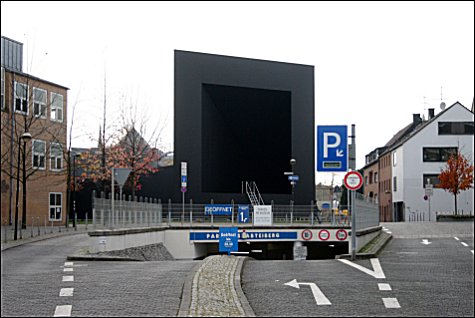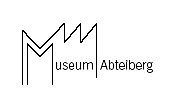Gregor Schneider: End
![]()
Gregor Schneider: END
The second phase of construction at
Museum Abteiberg in Mönchengladbach
Gregor Schneider’s concept for the second phase of construction at Museum Abteiberg takes the form of an over-dimensioned walk-in sculpture to be implemented as a temporary building.
Schneider’s concept envisages the museum as a black hole leading into an unknown space. The visitor enters it through a black opening. Total blackness removes all sense of place and engenders an experience of complete isolation, compelling visitors to feel their way along the walls of a corridor into total darkness, before eventually discovering a new entrance to the museum. The exhibition rooms located beyond the entrance are also entirely dark, their architecture vanishing into a black and obscure nothingness. Sensitised in this manner, visitors then enter Gregor Schneider’s innovative presentation of the museum’s collection, which includes original rooms from Haus u r.

Gregor Schneider has designed a new entrance for the Abteiberg Museum that is as monumental as it is mysterious. The huge walk-in sculpture will be erected on the lawn in front of the museum where the second part of the museum building, designed by Hans Hollein, will eventually be built. The front of the black edifice faces the vision axis of Mönchengladbach’s main shopping street. It will have a 14 x 14 meter square entrance, black both in- and outside and visible from afar, which will lead into a 70-meter long, totally dark corridor. It will extend diagonally in the shape of a tapering funnel, ending in a small, 1 x 1 meter hole that breaks through the closed museum wall and eventually reaches one of the ‘clover-leaf’ rooms in the museum interior.
The dimensions of this project both as urban architecture and a critical statement are one of its key features. This work was made possible by generous funding from the state of North-Rhine Westphalia (NRW) and the NRW Art Foundation as well as companies and private sponsors. The result is a major landmark that draws attention to what was previously a rather inconspicuous inner-city museum and endows its currently hidden entrances with new prominence. The enormous entrance tunnel, located in front of the museum on land due to become available for development, catches the eye from several perspectives including the central axis of Hindenburgstraße and the driveway from Abteistraße, virtually drawing the viewer’s gaze into itself.
Gregor Schneider and Museum Abteiberg are connected by both the locale and the concept, since Haus u r and the museum are both rooted in this city. Moreover, the ideas behind and history of Museum Abteiberg are closely associated with contemporary discourse on architectonic space. Not only Hans Hollein’s pioneering architecture, but also objects in the museum’s collection by his contemporary Gordon-Matta Clark, which were among its early acquisitions, testify to the museum’s special place in the discourse on the meaning of architecture.
It has therefore been one of the museum’s main wishes to acquire for the museum’s collection the central “Kaffee Zimmer” (Coffee Room) from Haus u r for its collection to join the “Abstellkammer” (Storeroom), which it purchased some time ago. It was equally important that the artist himself should design the installation for Museum Abteiberg. Here, Gregor Schneider further explores themes that have always been important to the museum: how to retrieve, present and communicate complex works of contemporary art that pose new challenges for museums (see also the artist’s extensive preliminary remarks: “Von der Zeit, da das immobile Haus mobil wurde” (About the time when the immobile house became mobile), interview in the June 2007 issue of Kunstforum International).
Starting from the museum’s acquisition of “Kaffeezimmer”, made possible by generous funding from the Kulturstiftung der Länder (KSL), the state of North-Rhine Westphalia and the Foundation for Culture and Science of Stadtsparkasse Mönchengladbach, Gregor Schneider designed a set of six rooms, which extend from the tunnel END inside the museum. The installation is staged in the completely darkened museum space, in which a number of rooms can be combined without having to refer to the surrounding architecture. The result is a stage-like presence, emphasising Gregor Schneider’s recent preoccupation with theatre and the importance of his film work. Alongside the illuminated original rooms, projections from Haus u r are presented together with unpublished film work that presents former villages in the nearby lignite mining fields as well as the house on Odenkirchener Straße in Rheydt (not far from Haus u r) where Joseph Goebbels was born. A further feature is the presentation of the geographical and historical origins of Schneider’s artistic discourse: the house in Rheydt and its regional vicinity, abandoned houses awaiting demolition and the landscapes of the Rhineland opencast mining industry, all traces of suppressed recent history. All these media will be used to create the “Smithsonesque” situation of a “non-site” in the museum (freely adapted from Robert Smithson’s dialectical thesis), which will be considerably enhanced by the special END entrance.
Website Museum Abteiberg Mönchengladbach
fleursdumal.nl magazine
More in: Architecture, Exhibition Archive, Galerie Deutschland, Gregor Schneider, Sculpture


